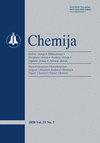Comparative investigation of oxidative degradation of organic dye in the presence of H2O2 and CuO nanoparticles synthesized by sol–gel method and green synthesis using flower (Matricaria chamomilla) extract
IF 0.4
4区 化学
Q4 CHEMISTRY, MULTIDISCIPLINARY
引用次数: 2
Abstract
2 Vytautas Magnus University, 58 K. Donelaičio Street, 44248 Kaunas, Lithuania In this study, CuO nanoparticles have been synthesized via a simple sol– gel method and green synthesis using flower (Matricaria chamomilla) extract. XRD analysis of the synthesized CuO nanoparticles clearly indicated a crystalline nature with a monoclinic structure regardless of the method of synthesis, while SEM revealed that the used synthesis methods affected the morphology of the CuO nanoparticles. The oxidative degradation kinetics of the organic dye Methyl Orange (MO) in the presence of the synthesized catalyst CuO and H2O2 has been investigated and compared depending on the dye concentration, reaction time and temperature. The catalytic activity of CuO was studied by measuring the UV–visible spectrum of the MO dye solution treated with CuO and H2O2. It was determined that the MO degradation reaction kinetics followed the pseudo-first-order mechanism. Thermodynamic studies indicated an endothermic nature (∆H# = +73.03 kJ mol–1) and a decrease in randomness at the catalyst CuO/solution interface during the reaction (∆S# = –0.021 kJ mol–1 K–1). At the same conditions, the green synthesized CuO nanoparticles exhibit similar activity properties as CuO synthesized using the sol–gel method. Besides, the green synthesis of CuO nanoparticles is simple and uses a small number of chemicals. The obtained CuO may be a promising catalyst for the oxidative degradation of organics, especially used in medical procedures.有机染料在H2O2和CuO存在下氧化降解的比较研究。溶胶-凝胶法制备纳米CuO与用洋甘菊提取物绿色合成
2 Vytautas Magnus大学,58 K.Donelaičio Street,44248 Kaunas,立陶宛。在本研究中,通过简单的溶胶-凝胶法合成了CuO纳米颗粒,并使用花(Matricaria chamomilla)提取物进行了绿色合成。合成的CuO纳米颗粒的XRD分析清楚地表明,无论合成方法如何,都具有单斜结构的结晶性质,而SEM显示所使用的合成方法影响了CuO纳米粒子的形态。研究了有机染料甲基橙(MO)在合成催化剂CuO和H2O2存在下的氧化降解动力学,并根据染料浓度、反应时间和温度进行了比较。通过测量用CuO和H2O2处理的MO染料溶液的紫外-可见光谱,研究了CuO的催化活性。确定MO降解反应动力学遵循伪一级机理。热力学研究表明,在反应过程中,催化剂CuO/溶液界面具有吸热性质(∆H#=+73.03 kJ mol–1)和随机性降低(∆S#=-0.021 kJ mol-1 K–1)。在相同的条件下,绿色合成的CuO纳米颗粒表现出与使用溶胶-凝胶法合成的CuO相似的活性特性。此外,CuO纳米颗粒的绿色合成非常简单,并且使用了少量的化学物质。所获得的CuO可能是有机物氧化降解的有前途的催化剂,特别是在医疗程序中使用。
本文章由计算机程序翻译,如有差异,请以英文原文为准。
求助全文
约1分钟内获得全文
求助全文
来源期刊

Chemija
化学-化学综合
CiteScore
1.30
自引率
16.70%
发文量
14
审稿时长
>12 weeks
期刊介绍:
Chemija publishes original research articles and reviews from all branches of modern chemistry, including physical, inorganic, analytical, organic, polymer chemistry, electrochemistry, and multidisciplinary approaches.
 求助内容:
求助内容: 应助结果提醒方式:
应助结果提醒方式:


